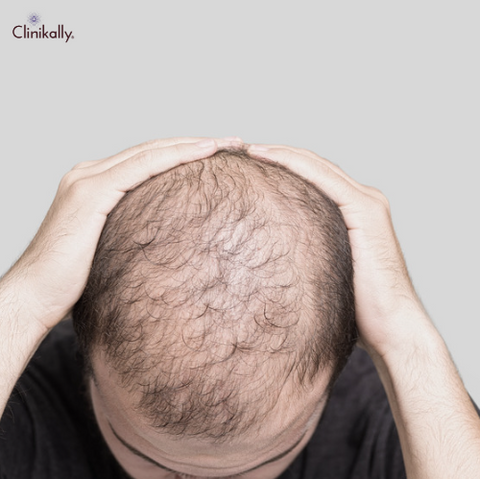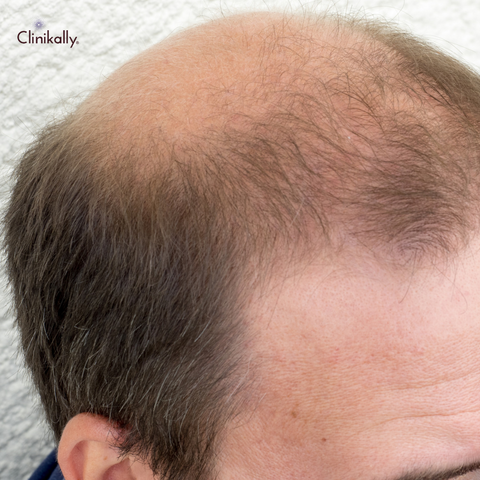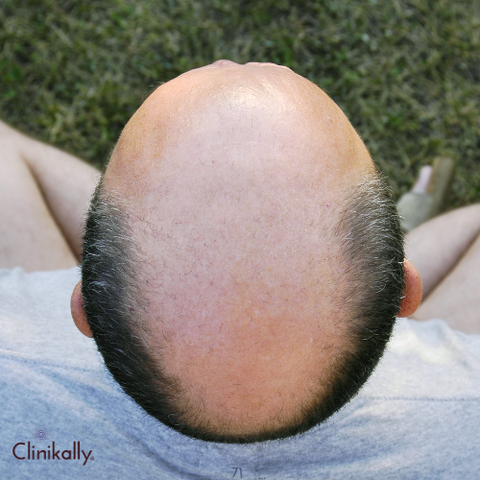Navigating the world of hair loss treatments can be daunting, but understanding the science behind your options can empower you to make informed decisions. In this blog, we will focus on Minoxidil and Finasteride, two FDA-approved medications with proven efficacy in treating hair loss. Our goal is to provide you with a detailed comparison of these treatments, delving into their uses, side effects, and benefits. Additionally, we will discuss various formulations, such as the combination of the two medications in topical solutions, and address frequently asked questions about their effectiveness.
By the end of this article, you'll have a comprehensive understanding of Minoxidil and Finasteride, allowing you to confidently choose the best treatment option for your unique hair loss situation. So, let's dive in and explore these powerful hair restoration medications!
What is Minoxidil?

Minoxidil is a vasodilator, initially developed to treat high blood pressure, which was later discovered to have hair growth-stimulating properties. It is an over-the-counter medication that has been FDA-approved for the treatment of androgenetic alopecia (male pattern baldness) and female pattern hair loss. Minoxidil works by increasing blood flow to the hair follicles, thereby promoting hair growth and potentially slowing down hair loss.
Minoxidil is available in different strengths, with the most common being 2% and 5% solutions. It is typically applied topically to the scalp once or twice a day, depending on the product's specific instructions. The exact mechanism of action of minoxidil on hair growth is not fully understood, but researchers believe it prolongs the anagen (growth) phase of the hair follicle cycle, ultimately leading to thicker and longer hair strands.
Minoxidil's Effectiveness
Minoxidil has been shown to be effective in promoting hair growth and slowing down hair loss in both men and women. However, results can vary from person to person. Studies have found that approximately 40% of men experience moderate to dense hair growth after using minoxidil for 3-6 months, while around 20% of women have similar results. It is important to note that minoxidil is more effective at maintaining existing hair and stimulating new growth in areas with miniaturised hair follicles rather than regrowing hair in completely bald areas.
Consistent use of minoxidil is crucial to achieve and maintain results. Discontinuation of the treatment often leads to a reversal of hair growth benefits, and hair loss may resume its natural progression. It is essential to set realistic expectations and be patient when using minoxidil, as noticeable improvements typically take several months to manifest.
Minoxidil is often used in combination with other hair loss treatments, such as finasteride, to increase the chances of success. In recent years, various formulations have emerged that include minoxidil and finasteride in a single topical solution, providing the benefits of both medications in a convenient and easy-to-use product. These combined treatments have gained popularity among hair loss sufferers seeking comprehensive and effective solutions for their hair restoration journey.
What is Finasteride

Finasteride is an oral medication that has been FDA-approved for the treatment of androgenetic alopecia (male pattern baldness). It belongs to a class of drugs known as 5-alpha-reductase inhibitors. Finasteride works by inhibiting the conversion of testosterone to dihydrotestosterone (DHT), a hormone that plays a significant role in hair loss. By reducing DHT levels in the scalp, finasteride helps prevent hair follicle miniaturisation, slowing down hair loss and, in some cases, promoting hair regrowth.
Finasteride is typically prescribed in a 1mg dose, taken once daily. It is essential to note that finasteride is approved only for men, as its use in women, especially those who are pregnant or may become pregnant, can lead to birth defects. However, some off-label use in postmenopausal women has been reported under strict medical supervision.
Finasteride's Effectiveness
Finasteride has been shown to be highly effective in treating male pattern baldness, with clinical studies demonstrating significant improvements in hair count and overall hair quality. In a five-year study, around 65% of men who took finasteride experienced hair regrowth, while 83% had no further hair loss. Finasteride is most effective in maintaining and improving hair in the vertex (crown) and mid-scalp areas, although it may also provide benefits for hairline recession.
As with minoxidil, consistent use of finasteride is vital for achieving and maintaining results. Discontinuing the medication will likely result in a reversal of benefits, and hair loss may continue at its natural pace. It may take several months of daily use to see noticeable improvements, so patience and persistence are key when using finasteride.
In recent years, topical finasteride solutions have emerged as an alternative to oral finasteride, aiming to provide similar benefits with potentially fewer systemic side effects. Additionally, combined treatments that include both minoxidil and finasteride in a single topical solution have gained popularity among individuals seeking a comprehensive approach to hair restoration. These innovative formulations allow users to reap the benefits of both medications, potentially enhancing the overall effectiveness of their hair loss treatment regimen.
Hair Loss Treatment: Minoxidil vs Finasteride

When choosing between minoxidil and finasteride for hair loss treatment, it is crucial to understand their differences and determine which medication is better suited to your individual needs. Here is a comparison of these two popular treatments, highlighting their key characteristics:
Minoxidil:
-
Topical solution applied directly to the scalp
-
FDA-approved for both male and female pattern hair loss
-
Works by increasing blood flow to the hair follicles
-
Available in 2% and 5% concentrations
-
Effective in promoting hair growth and slowing hair loss, with varying results among users
-
Must be used consistently for optimal results
Finasteride:
-
Oral medication taken once daily (topical solutions also available)
-
FDA-approved for male pattern baldness only
-
Works by inhibiting the conversion of testosterone to DHT
-
Prescribed in a 1mg dose
-
Highly effective in treating male pattern baldness, with significant improvements in hair count and quality
-
Must be used consistently for optimal results
|
Minoxidil |
Finasteride |
|
|
Formulation |
Topical solution |
Oral or topical |
|
FDA Approval |
Male & Female pattern |
Male pattern only |
|
Mechanism of Action |
Vasodilation |
5-alpha-reductase inhibition |
|
Availability |
Over-the-counter |
Prescription |
|
Effectiveness |
Varies among users |
High in male pattern |
|
Consistency Required |
Yes |
Yes |
In some cases, using minoxidil and finasteride together may provide better results than using either treatment alone. The combination of these two medications can target different aspects of hair loss, potentially creating a synergistic effect. Some individuals may choose to use a topical solution that combines minoxidil and finasteride, offering a convenient and effective hair restoration solution.
Ultimately, the choice between minoxidil and finasteride will depend on your specific hair loss situation, preferences, and any potential contraindications. It is always recommended to consult with a healthcare professional to determine the best course of action for your hair loss treatment.
Can Minoxidil and Finasteride be used together?
Yes, minoxidil and finasteride can be used together, and combining these two treatments may provide enhanced results for some individuals. The rationale behind this combination is that minoxidil and finasteride target different aspects of hair loss, working through distinct mechanisms of action. Minoxidil promotes hair growth by increasing blood flow to the hair follicles, while finasteride prevents hair loss by inhibiting the conversion of testosterone to DHT. By addressing these two aspects simultaneously, the combination of minoxidil and finasteride may create a synergistic effect, potentially improving overall hair restoration outcomes.
Many hair loss sufferers have reported success with this combined approach. Some use oral finasteride alongside topical minoxidil, while others opt for a combined topical solution that incorporates both medications. These dual-action formulations offer a convenient and efficient way to reap the benefits of both minoxidil and finasteride in a single product.
It is important to note that while using minoxidil and finasteride together can be an effective strategy for some individuals, the combination may not be suitable for everyone. Factors such as personal preferences, potential side effects, contraindications, and the severity of hair loss should be considered before starting a combined treatment regimen. Always consult with a healthcare professional to determine the best course of action for your specific hair loss situation.
In summary, combining minoxidil and finasteride can provide an enhanced approach to hair loss treatment for some individuals. By targeting different aspects of hair loss through their unique mechanisms of action, these medications may work together to improve overall hair restoration outcomes. However, it is essential to consult with a healthcare professional to determine if a combined treatment is appropriate for your specific needs.
How long does it take for hair regrowth?
The time it takes for hair regrowth to become noticeable varies among individuals and depends on several factors, such as the severity of hair loss, the chosen treatment, and individual response to the medication. When using minoxidil or finasteride, patience and persistence are essential, as it can take several months to see noticeable improvements.
For minoxidil users, initial results may appear within 3-6 months of consistent use, with more significant improvements observed after 6-12 months. It is crucial to continue using minoxidil as directed, as discontinuing the treatment can lead to a reversal of benefits and resumption of hair loss.
Finasteride users may begin to see noticeable improvements within 3-6 months as well, but the most significant results are typically observed after 6-12 months of consistent use. As with minoxidil, it is vital to maintain the treatment regimen, as stopping finasteride may result in a reversal of benefits and continued hair loss.
When using a combination of minoxidil and finasteride, the timeline for hair regrowth may be similar to using either treatment alone. However, the combined treatment could potentially lead to more robust results over time.
It is essential to manage expectations and understand that hair regrowth is a gradual process that requires consistent effort. While some individuals may experience faster results, others may need more time to see noticeable improvements. Consulting with a healthcare professional and following the recommended treatment regimen can maximise the chances of successful hair restoration.
Which topical treatment is better according to hair loss condition?
Minoxidil and Finasteride are two popular topical treatments for hair loss. However, their effectiveness varies depending on the specific hair loss condition. Below is a comparison of these treatments for different hair loss conditions.
|
Hair Loss Condition |
Minoxidil |
Finasteride |
|
Male Pattern Baldness (MPB) |
Effective for slowing hair loss and promoting regrowth |
More effective in preventing further hair loss and regrowing hair |
|
Female Pattern Hair Loss |
Effective for treating hair loss and promoting regrowth |
Not recommended for women, especially those who are pregnant or may become pregnant |
|
Telogen Effluvium |
May provide temporary relief, but addressing the underlying cause is essential |
Not typically recommended; focus on addressing the underlying cause |
|
Beard Hair Loss |
Limited evidence for effectiveness; more research needed |
Not recommended; not designed for facial hair |
-
Minoxidil is an over-the-counter treatment that works by increasing blood flow to the hair follicles, promoting hair growth.
-
Finasteride, available by prescription, is an oral medication that inhibits the conversion of testosterone to dihydrotestosterone (DHT), a hormone that contributes to hair loss.
In conclusion, Minoxidil and Finasteride are effective treatments for certain hair loss conditions, such as male pattern baldness. However, it is crucial to consult a healthcare professional before starting any treatment to determine the best course of action based on the specific hair loss condition.
Side Effects of Minoxidil and Finasteride
Minoxidil and Finasteride, while effective for treating hair loss, may also have side effects. Understanding these side effects can help individuals make informed decisions about their hair loss treatments. Here's a brief overview of the potential side effects of Minoxidil and Finasteride:
Minoxidil:
-
Scalp irritation: Minoxidil may cause itching, redness, or dryness on the scalp.
-
Unwanted hair growth: In some cases, Minoxidil may cause hair growth on unintended areas, such as the face.
-
Dizziness: Some users may experience dizziness or light-headedness due to a drop in blood pressure.
-
Rapid heartbeat: Minoxidil can cause an increased heart rate in rare instances.
Finasteride:
-
Sexual side effects: Finasteride may cause a decreased libido, erectile dysfunction, or changes in ejaculation.
-
Breast tenderness or enlargement: Some men may experience breast changes while using Finasteride.
-
Depression: Finasteride use has been linked to an increased risk of depression in some users.
-
Allergic reactions: Rarely, individuals may experience an allergic reaction to Finasteride, which could include symptoms like rash, itching, or swelling.
While most people tolerate these medications well, it is essential to be aware of the potential side effects. If you experience any adverse reactions while using Minoxidil or Finasteride, consult your healthcare professional promptly. They can help determine if the medication is suitable for you and suggest alternative treatments if necessary.
Final Verdict: Which Hair Loss Treatment is Best Suited for You
In conclusion, both Minoxidil and Finasteride can be effective treatments for certain hair loss conditions, particularly male pattern baldness. However, their efficacy and suitability depend on the individual's specific hair loss condition and personal circumstances.
Minoxidil is a versatile, over-the-counter solution that works well for both men and women experiencing hair loss. It has relatively mild side effects, making it a good starting point for those new to hair loss treatments.
Finasteride, on the other hand, is a prescription medication that has shown more substantial results for men with male pattern baldness. However, its potential side effects, particularly concerning sexual function, should be considered before starting the treatment. Finasteride is not recommended for women, especially those who are pregnant or may become pregnant.
Ultimately, the best hair loss treatment for you will depend on your specific hair loss condition, medical history, and personal preferences. It's essential to consult a healthcare professional to help you make an informed decision and develop a tailored treatment plan that addresses your unique needs. Don't be discouraged by hair loss – with the right approach and guidance, you can find a treatment that works for you and helps you regain your confidence.

















2 comments
Neha
I have used Minoxidil+Finasteride hair serum unknowingly unaware that it is not for ladies.
I have used it twice or thrice.
Is there any side effects please reply.
I have used Minoxidil+Finasteride hair serum unknowingly unaware that it is not for ladies.
I have used it twice or thrice.
Is there any side effects please reply.
MD Ibrahim
I’m interested
I’m interested